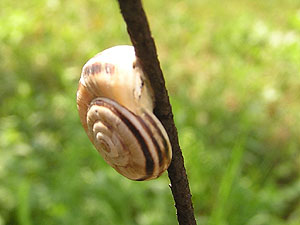
Eastern or white heath snail (Xerolenta obvia) on a wire mesh
fence in Vienna. [RN]
Systematics
According to Falkner
(1990)
 Eastern or white heath snail (Xerolenta obvia) on a wire mesh fence in Vienna. [RN] |
Superfamily Helicacea
![]() Family
Hygromiidae
Family
Hygromiidae
![]() Helicella itala
(Linnaeus 1758)
Helicella itala
(Linnaeus 1758)
![]() Xerolenta obvia
(Menke 1828)
Xerolenta obvia
(Menke 1828)
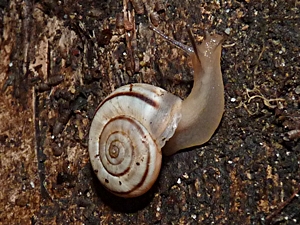 Eastern heath snail (Xerolenta obvia). Picture: Martina Eleveld. |
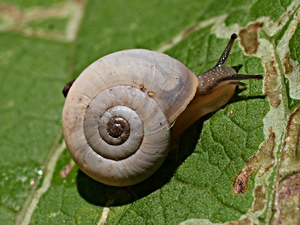 A white specimen of Xerolenta obvia. Picture: © Alexander Mrkvicka, Vienna (mrkvicka.at). |
Heath snails are called that way because of their occurring predominantly in dry, open habitats, such as heath, dunes and sand hills, open meadows and rocky hillsides. On warm summer days they can often be seen aestivating on bushes in great numbers, such as the snails in the pictures from the eastern outskirts of Vienna.
A heath snail's shell is characteristically white coloured, even as long as the snail is alive. Usually there are several dark bands.
In Central Europe the two most frequent species are Helicella itala, the western, and Xerolenta obvia, the eastern heath snail. Both species are very similar to each other, their shells having 5 – 6 whorls ascending only little, so the spire appears flattened. In both species there is only little trace of an apertural lip, so that the aperture rim is almost as sharp as that of a juvenile snail.
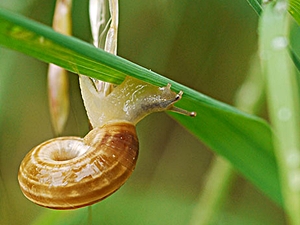 Western heath snail (Helicella itala) from Switzerland. Picture: © Stefan Haller, (schneckenfoto.ch). |
In general, the bands on a Helicella itala shell are more brownish in colour, Xerolenta obvia being almost black-and-white in colour.
Both species, though, have in common a wide open and well recognisable umbilicus or shell navel, which extends to a third of the shell width in Helicella itala, even a fourth of it in Xerolenta obvia.
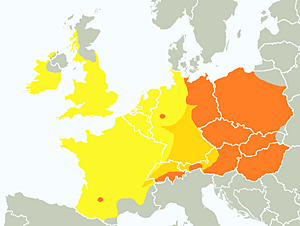 Source: Kerney et al. (1983). Modified: RN. |
The distribution area of both species is different, Helicella itala found in all of Western Europe, north into southern Scandinavia and east into Central Germany and western Lower Austria.
Xerolenta obvia, on the other hand, occurs from Asia Minor (Turkey) over the eastern and central Balkan Peninsula up to the southern coast of the Baltic sea and west until south eastern France. The western border of Xerolenta obvia's distribution area is a line between Heidelberg in the south and Lübeck in the north.
![]() Map on the left: Distribution area
of Helicella itala (yellow) and Xerolenta obvia (orange) in North
and Central Europe. In the dark yellow area, both species are present. The distribution area is only displayed within the limits covered by Kerney et al. (1979, 1983).
Map on the left: Distribution area
of Helicella itala (yellow) and Xerolenta obvia (orange) in North
and Central Europe. In the dark yellow area, both species are present. The distribution area is only displayed within the limits covered by Kerney et al. (1979, 1983).
In English, Xerolenta obvia is usually called the white heath snail. But this is rather incorrect, as a large (if not the largest) portion of Xerolenta obvia specimens is banded black and white. Besides, there are numerous other heath snail species, which also have white forms.
Taking into account the distribution patterns of both described species, calling them eastern and western heath snail seems to be appropriate.
![]() Michal Maňas'
Posterous: Blog About Gastropods:
Mating of Xerolenta obvia.
Michal Maňas'
Posterous: Blog About Gastropods:
Mating of Xerolenta obvia.
![]() Leaf Snails (Hygromiidae), the relatives of heath snails.
Leaf Snails (Hygromiidae), the relatives of heath snails.
 With pictures by Stefan Haller: http://www.schneckenfoto.ch. |